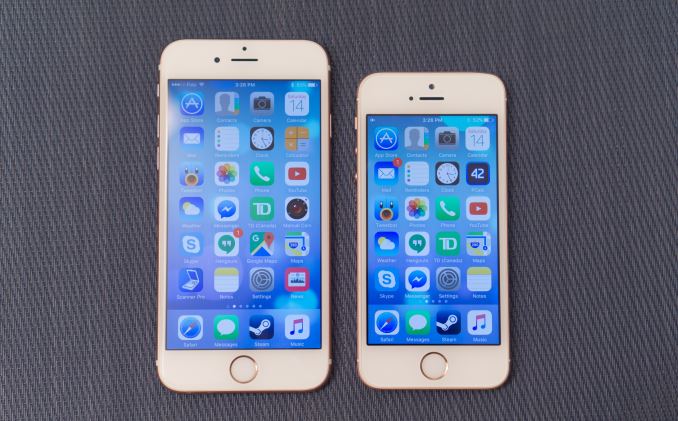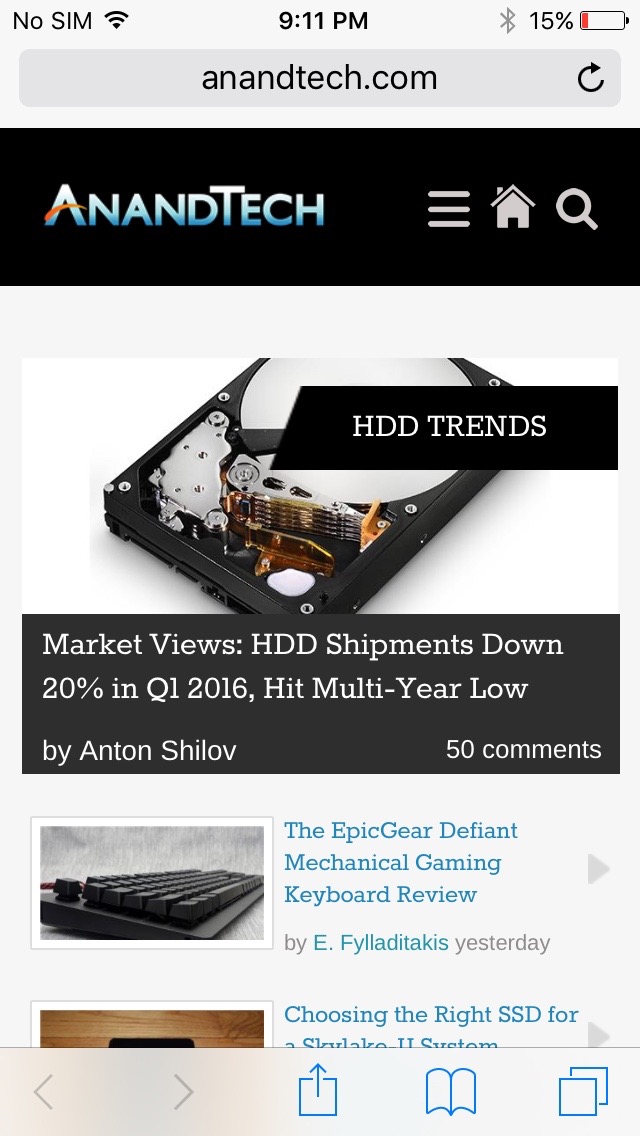The iPhone SE Review
by Brandon Chester on May 16, 2016 8:00 AM EST- Posted in
- Smartphones
- Apple
- Mobile
- iPhone
- iPhone SE
Going Back To A 4-Inch Smartphone
The Android world left the 4-inch smartphone behind long ago. While Apple was still playing the 3.5-inch smartphone game, Android phones moved from 4 inches, to 4.3 inches, to 4.5 inches, and so on. Nowadays, your standard Android flagship phone has a display that is a little over five inches in size, and a 4.5-inch display is what’s considered a tiny phone. Of course, there are other factors related to device size like whether you have physical or on-screen buttons and how large your bezel is, but the screen size is still what defines the limits of your window into the internet and all your applications. A couple of years ago I used the iPhone 5s, and nowadays I use the Nexus 5X and the iPhone 6s. Devices that really bring total device size up a notch like the Galaxy Note 5 and iPhone 6s Plus are simply far too large for me to use comfortably. Even with that, going back to a 4-inch smartphone definitely takes time to get used to, and it’s given me some interesting insights into what you gain and what you lose by moving to a larger device.
My first point about the iPhone SE seems patently obvious, but it’s really worth stating that when you move from a 5-inch smartphone to a 4-inch one it really feels small. I’ve actually been having some interesting thoughts on this subject as I’ve juggled between various iPads for the upcoming 9.7-inch iPad Pro review. If you use the iPad Mini for a long time, a 9.7-inch iPad feels absolutely enormous by comparison. Similarly, when you use the 12.9-inch iPad Pro for a long time, the 9.7-inch iPad feels like an iPad Mini in comparison, and the Mini itself feels absurdly small. In all these cases there’s an adjustment period where one has to get used to the size of the device, and after that time passes it becomes your reference point for what is normal.
I don’t expect that too many users will actually go through this adjustment period if they buy the iPhone SE, as I would imagine that many prospective buyers are people who are still holding on to their iPhone 5 or 5s and have been hoping for an updated 4-inch iPhone. After getting used to the SE, I’ve found myself enjoying the one-handed usability. Say what you will about features like reachability and one-handed modes; the 4-inch screen is simply much easier to use with one hand. I never worry about dropping the phone, and I don’t find myself having to shift my hand to reach the upper left area of the display.
On the flip side, the 4-inch form can feel quite cramped, even after adjusting to the smaller display size. With the default settings the information density is absolutely laughable, and I can’t use the phone without the text size setting set to the smallest value. I use the smallest text size on all my devices, but for users who need a larger font due to aging eyes I would honestly rule out the iPhone SE immediately unless you’re comfortable with doing a lot of scrolling. Even with that changed, you simply can’t fit near as much on the screen. You get one fewer row of home screen icons, fewer emails in the Mail app, no avatars in the Messages app, and similar reductions throughout the rest of Apple’s apps as well as third party ones. Features like Control Center which just goes past the halfway point on the 6s takes up nearly the entire screen, and it makes me wonder how it ever even fit on the 3.5-inch iPhones.
All of these changes are just a function of the display size, and while they seem obvious, it’s difficult to understand the extent to which they change the experience of using the phone. While I’m not someone who is sold on phablets, I certainly see the value in them for many people, and for me the sweet spot is something in the 4.5 to 4.7-inch range. I’ve used the iPhone SE as my primary device for a month now to see how it works for me, and when I returned to the Nexus 5X and iPhone 6s they both felt absolutely enormous. However, I find myself really valuing the additional information that I can see in the larger display while still having the phones be relatively usable with a single hand. The 4-inch screen isn’t the right size for me, but I recognize the benefits of it. With Apple having sold 30 million 4-inch smartphones last year despite the fact that their offering was a phone from 2013, there’s clearly a market for such a device, and I think the iPhone SE will make those users quite happy.













138 Comments
View All Comments
michael2k - Tuesday, May 17, 2016 - link
Why is that review a joke? Look at this review, with it's graphs! NAND, CPU, and GPU are essentially the same as the iPhone 6S, and the battery life is a little better.Eden-K121D - Tuesday, May 17, 2016 - link
LOLfm13 - Wednesday, May 18, 2016 - link
any plans to review Xiaomi Mi5?chris.london - Monday, May 16, 2016 - link
Could you please run a few storage benchmarks on the SE? I would love to see if Apple skimped on the storage or not.CloudWiz - Monday, May 16, 2016 - link
^ This please, I couldn't find any good storage benchmarks online about the SE. The storage is definitely faster than on my old iPhone 5, but I'm pretty sure it's not as great as the NVMe on the 6s. I wonder if they're using NVMe on this phone or something slower like on the 6.Brandon Chester - Monday, May 16, 2016 - link
We're a bit iffy on what to do about storage benchmarking going forward due to issues with the tools available on the Android side. I've updated page two with NAND results for anyone who is interested.CloudWiz - Wednesday, May 18, 2016 - link
Thanks so much Brandon! Wow, I did not expect them to use the same storage. Kudos to Apple for fitting so much of the latest and greatest while still keeping it cheap.leexgx - Tuesday, May 17, 2016 - link
hey really need to drop the 16GB model (32GB should be the min on a iphone)michael2k - Tuesday, May 17, 2016 - link
As the single largest buyer of NAND, doing so would cause a flash shortage and drive up prices everywhere, or force everyone else to use less storage. Essentially if you double from 16GB to 32GB you should expect NAND prices for 32GB parts to go up to $12 and the 16GB parts to drop below $2.Apple uses a single $8.4 256Gb NAND chip, to hit 32GB:
http://www.insye.com/DP/NANDFlashContractPrice.asp...
LauRoman - Monday, May 16, 2016 - link
http://anandtech.com/show/7335/the-iphone-5s-revie...